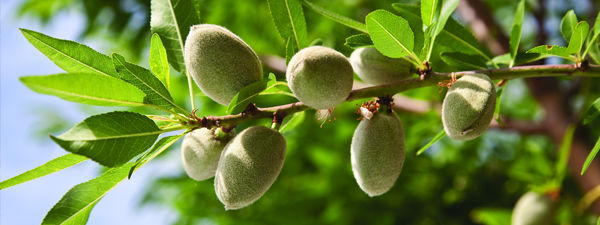Protecting Almonds Through Petal Fall
January 31, 2022

Almond growers know they have a narrow window from pink bud to petal fall to prevent brown rot blossom blight (Monilinia laxa and occasionally M. fructicola) and other diseases from reducing yields. Carefully monitoring environmental factors during this critical period, and taking the appropriate steps to prevent disease, can be the difference between a healthy, productive crop and a season of complications.
Relevant: Prevention is Key for Tree Nut Growers
Specific conditions favor disease development. For example, for blossom infection to occur at 50 degrees, 18 hours of leaf wetness (LW) are required. At 68 degrees, only 8 hours of LW are needed. Temperature also affects the rate of symptom development. At high humidity, gray to tan spore masses quickly form on diseased flower parts and twig cankers. The stamens and pistils are the most susceptible parts of the flower.
It is also important to understand how brown rot and shot hole can overwinter. Monilinia spp. survive in twig cankers and mummified fruit and blossoms and, in the case of Wilsonomyces carpophilus, the shot hole pathogen, spores survive on contaminated buds and twigs. Spores from these overwintering sites are then dispersed by wind and rain onto new emerging tissue, which varies in its susceptibility.
Timing fungicide applications is an important factor to curtailing brown rot, shot hole, anthracnose, green fruit rot and other diseases, but environmental conditions may delay optimal scheduling of application. According to the University of California, a single application made at 20 to 40 percent bloom is sufficient for reliable disease control, under less than favorable disease conditions. However, when conditions are favorable, a two-spray program with applications at pink bud and full bloom is recommended.
Relevant: Scala + Luna: from Bud to Bloom to Better Yield
To assist growers, consultants, and pest control advisers in understanding disease risks and protection benefits, Dr. James Adaskaveg, professor and plant pathologist from the University of California, Riverside, conducts yearly trials on a variety of fungicides and ranks them according to field results. At the end of the season, he issues a Fungicide Efficacy Trials Report that rates the effectiveness of each product.
In Adaskaveg’s 2013 report, Luna® Sensation from Crop Science earned four out of four pluses for both brown rot and shot hole. Four pluses are awarded for excellent and consistent fungicide efficacy; three equals good and reliable; two pluses is characterized as moderate and variable; one plus is limited and erratic; and those receiving less than one plus are considered ineffective.
Adaskaveg also rates treatment timing. He found that the most effective time to treat brown rot is at full bloom. Pink bud is moderately effective, while petal fall is rated the least successful time to spray.
Luna Sensation has consistently proven itself year after year to provide efficacy equal or superior to leading fungicides for control of brown rot blossom blight, shot hole and other foliar diseases affecting almonds. Luna Sensation also penetrates into flower buds and offers systemic protection against disease as blossoms open.
At pink bud, before bloom, Scala® fungicide, also from Crop Science, provides excellent control against a variety of damaging diseases that cause yield losses and also helps control many resistant disease strains. As Scala is effective to use across a range of temperatures and wet and rainy weather, it is an ideal choice to use as an early season spray.
As disease management plans are put into place for this season, it is important to remember that most fungicides are applied as a protective measure. For this reason, it is best to spray fungicides early in the season, prior to a rain event, to help see higher yields at the end of the season.